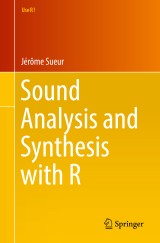Details

Sound Analysis and Synthesis with R
Use R!
|
80,24 € |
|
| Verlag: | Springer |
| Format: | |
| Veröffentl.: | 06.06.2018 |
| ISBN/EAN: | 9783319776477 |
| Sprache: | englisch |
Dieses eBook enthält ein Wasserzeichen.
Beschreibungen
<p>Sound is almost always around us, anywhere, at any time, reaching our ears and stimulating our brains for better or worse. Sound can be the disturbing noise of a drill, a merry little tune sung by a friend, the song of a bird in the morning or a clap of thunder at night. The science of sound, or acoustics, studies all types of sounds and therefore covers a wide range of scientific disciplines, from pure to applied acoustics. Research dealing with acoustics requires a sound to be recorded, analyzed, manipulated and, possibly, changed. This is particularly, but not exclusively, the case in bioacoustics and ecoacoustics, two life sciences disciplines that attempt to understand and to eavesdrop on the sound produced by animals. Sound analysis and synthesis can be challenging for students, researchers and practitioners who have few skills in mathematics or physics. However, deciphering the structure of a sound can be useful in behavioral and ecological research – and also very amusing.</p>
<p>This book is dedicated to anyone who wants to practice acoustics but does not know much about sound. Acoustic analysis and synthesis are possible, with little effort, using the free and open-source software R with a few specific packages. Combining a bit of theory, a lot of step-by-step examples and a few cases studies, this book shows beginners and experts alike how to record, read, play, decompose, visualize, parametrize, change, and synthesize sound with R, opening a new way of working in bioacoustics and ecoacoustics but also in other acoustic disciplines.<br></p>
<p>This book is dedicated to anyone who wants to practice acoustics but does not know much about sound. Acoustic analysis and synthesis are possible, with little effort, using the free and open-source software R with a few specific packages. Combining a bit of theory, a lot of step-by-step examples and a few cases studies, this book shows beginners and experts alike how to record, read, play, decompose, visualize, parametrize, change, and synthesize sound with R, opening a new way of working in bioacoustics and ecoacoustics but also in other acoustic disciplines.<br></p>
<p>Introduction.- What Is Sound?.- What Is R?.- Playing with Sound.- Display of the Wave.- Edition.- Amplitude Parametrization.- Time-Amplitude Parametrization.- Introduction to Frequency Analysis: the Fourier Transformation.- Frequency, Quefrency, and Phase in Practice.- Spectrographic Visualization.- Mel-Frequency Cepstral and Linear Predictive Coefficients.- Frequency and Energy Tracking.- Frequency Filters.- Other Modifications.- Indices for Ecoacoustics.- Comparison and Automatic Detection.- Synthesis.</p>
<div>Dr. Jérôme Sueur is an associate professor at the Muséum national d'Histoire naturelle in Paris, France. He has developed several research projects all dealing with acoustics, animal behaviour and ecology. His work is internationally acknowledged and he is an expert in animal communication and biodiversity assessment through acoustic techniques. He is considered a leader of the recent emergence of ecoacoustics, a new scientific discipline that combines acoustics and ecology at a large spatio-temporal scale. He developed the R package 'seewave' which is used in more than 110 countries by researchers in bioacoustics and ecoacoustics, and also in speech analysis, telemetry, medical sciences, geology, and spatial engineering.<br></div>
<p>Sound is almost always around us, anywhere, at any time, reaching our ears and stimulating our brains for better or worse. Sound can be the disturbing noise of a drill, a merry little tune sung by a friend, the song of a bird in the morning or a clap of thunder at night. The science of sound, or acoustics, studies all types of sounds and therefore covers a wide range of scientific disciplines, from pure to applied acoustics. Research dealing with acoustics requires a sound to be recorded, analyzed, manipulated and, possibly, changed. This is particularly, but not exclusively, the case in bioacoustics and ecoacoustics, two life sciences disciplines that attempt to understand and to eavesdrop on the sound produced by animals. Sound analysis and synthesis can be challenging for students, researchers and practitioners who have few skills in mathematics or physics. However, deciphering the structure of a sound can be useful in behavioral and ecological research – and also very amusing.</p><p>This book is dedicated to anyone who wants to practice acoustics but does not know much about sound. Acoustic analysis and synthesis are possible, with little effort, using the free and open-source software R with a few specific packages. Combining a bit of theory, a lot of step-by-step examples and a few cases studies, this book shows beginners and experts alike how to record, read, play, decompose, visualize, parametrize, change, and synthesize sound with R, opening a new way of working in bioacoustics and ecoacoustics but also in other acoustic disciplines.</p>
Details sound analysis and synthesis principles Opens the “black box” of sound analysis with simple and easy-to- understand language Shows numerous step-by-step R code examples of how to run a sound analysis Describes how to process automatic analysis of groups of recordings (batch analysis)

















